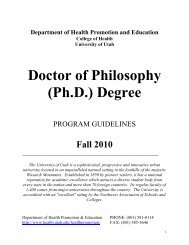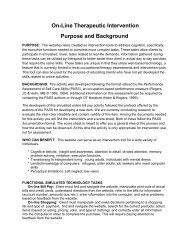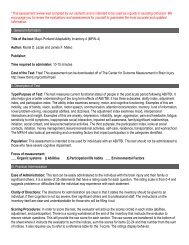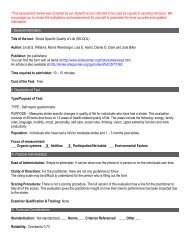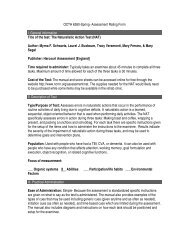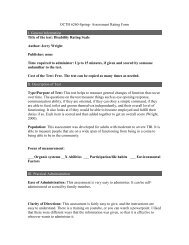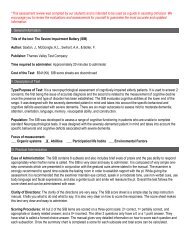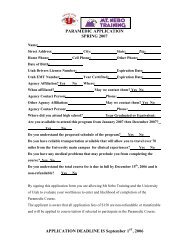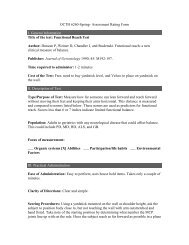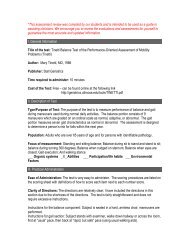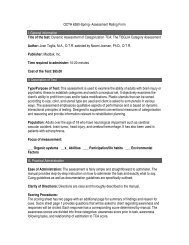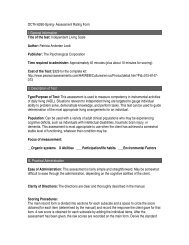Revisiting speech rate and utterance length ... - ResearchGate
Revisiting speech rate and utterance length ... - ResearchGate
Revisiting speech rate and utterance length ... - ResearchGate
You also want an ePaper? Increase the reach of your titles
YUMPU automatically turns print PDFs into web optimized ePapers that Google loves.
M. Blomgren, A.M. Goberman / Journal of Communication Disorders 41 (2008) 159–178 173relatively syntax-free process. Similar to the work of Ratner <strong>and</strong> Sih (1987) <strong>and</strong> Kleinow<strong>and</strong> Smith (2000), future studies in this areas may control for this possible processingdifference by comparing phrases of varying <strong>length</strong>s <strong>and</strong> complexities, rather thancomparing single words to phrases.4.3. Clinical implicationsResults from the present study suggest that fluency breakdown can be plotted along aspatiotemporal continuum of increasingly difficult <strong>speech</strong> task performance. Magill (2004)indicated that a 2 2 performance matrix could be applied to assessment of motorperformance <strong>and</strong> to aid in structuring motor skill learning. In this context, motorperformance relates to the observable behavior produced during any motor task. Incontrast, motor learning is described as a modification in behavior that results from practiceor experience (Sage, 1984). Fitts (1964) suggested that the basic issue in describing motorskill learning has to do with detailing how spatial <strong>and</strong> temporal organization develops. Byutilizing the performance matrix as a stuttering assessment st<strong>rate</strong>gy, multidimensionalseverity information may be obtained. While the mean group data reported in this papersuggests levels of both <strong>length</strong> of <strong>utterance</strong> <strong>and</strong> <strong>speech</strong> <strong>rate</strong> stability played similar roles inmodulating stuttering frequency, this may not be the case for all individual stutteringspeakers. For instance, as the stuttering severity analyses in this study appears to indicate,stuttering may be modulated more by decreases in temporal stability in some stutteringspeakers <strong>and</strong> more by increased <strong>length</strong> of <strong>utterance</strong> dem<strong>and</strong>s in other speakers. In thisrespect, the 2 2 performance matrix may be a useful clinical assessment tool indisentangling the motor dynamics of some stuttering speakers.Magill (2004) <strong>and</strong> Hautala <strong>and</strong> Conn (1993) have revealed that a 2 2 skill matrix isuseful in examining gross motor skill learning. The results from this study indicated that a2 2 skill matrix might also be beneficial in examining fluency skill development tasks.Although skill learning was not directly evaluated in this study, it seems plausible that the2 2 format could have therapeutic implications. Specifically, the 2 2 matrix might beused to structure a learning hierarchy that fosters improved fluency success in treatment.Application of some form of closed to open continuum of <strong>speech</strong> motor performance to theclinical setting has been the backbone of behaviorally based stuttering treatments for over100 years (e.g., Blomgren, 2005; Boberg & Kully, 1985; Guttmann, 1893; Ryan, 1979;Shine, 1980; Webster, 1982). However, a formalized multidimensional assessment couldbe used to customize the therapy routine based on the unique motor performancecharacteristics of individual speakers. For example, if a particular stuttering speakerexhibited decreasing fluency primarily as a function of speaking <strong>rate</strong> complexity, thentherapy could be programmed to address this <strong>speech</strong> dimension. If another stutteringspeaker exhibited little stuttering in the production of single words, then instatement offluency facilitating techniques might begin directly with longer <strong>utterance</strong>s for thatindividual, bypassing single word practice altogether. Overall, stuttering treatment timecould potentially be decreased <strong>and</strong> made more relevant for clients. While the effectivenessof utilizing multidimensional performance matrices to improve treatment has not yet beenexamined, the present results provide support for the functionality of evaluating stutteringbehavior using a <strong>speech</strong> motor performance st<strong>rate</strong>gy.



